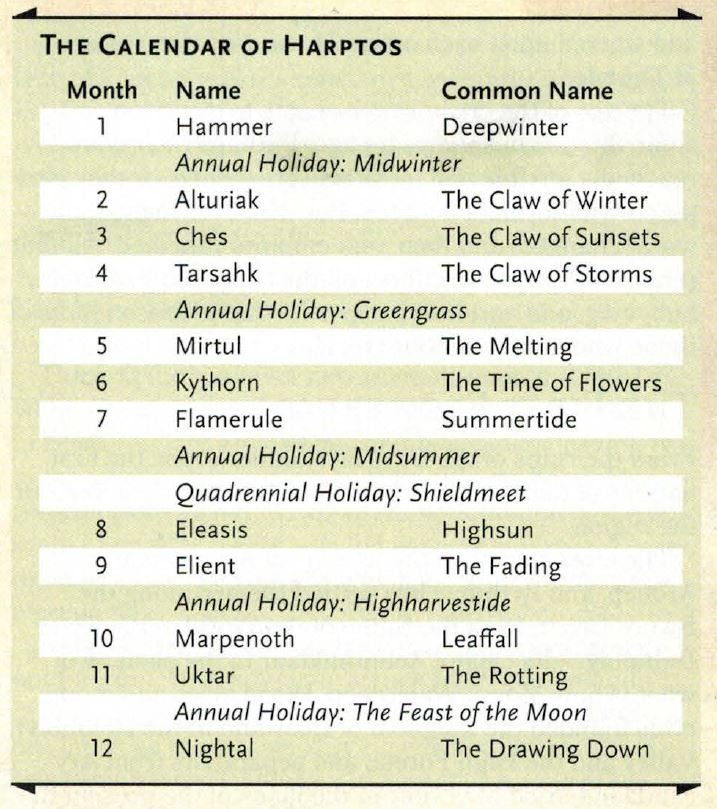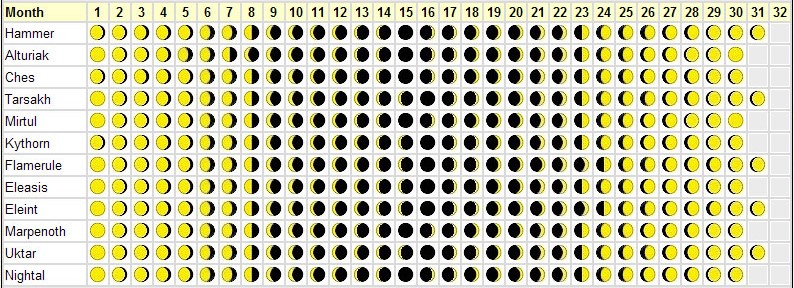Time in the Realms
 Although a number of means exist for marking the days and the passage of time during a year, nearly all folk in Faerûn have adopted the Calendar of Harptos. Even the cultures and races that don’t favor this method of marking time are aware of it, with the result that it is recognized across nearly all races, languages, and cultures.
Although a number of means exist for marking the days and the passage of time during a year, nearly all folk in Faerûn have adopted the Calendar of Harptos. Even the cultures and races that don’t favor this method of marking time are aware of it, with the result that it is recognized across nearly all races, languages, and cultures.
A year on Tori! consists of 365 days. In the Calendar of Harptos, the year is divided into twelve months of thirty days, loosely following the synodic cycle of Selûne, the moon. A month is made up of three “tendays,” also known as “rides.” Five annual holidays, falling between the months, complete the 365-day calendar. Once every four years, the Calendar of Harptos includes Shieldmeet as a “leap day” following Midsummer.
Individual days of a tenday have no special names. Instead, they are denoted by counting from the beginning of the period (“first day,” “second day,” and so on). Days of the month are designated by a number and the month name. For example, sages would record an event as occurring on “1 Mirtul” or “27 Uktar.” People might also refer to a given day by its relationship to the current date (“two tendays from today”) or the nearest holiday (“three days past Greengrass”).
![]()
Keeping Time from Day to Day
Most people don’t keep track of the time of day beyond notions such as “mid-morning” or “nigh sunset.” If people plan to meet at a particular time, they tend to base their arrangements around such expressions.
The concept of hours and minutes exists mainly where wealthy people use clocks, but mechanical clocks are often unreliable, and rarely are two set to the same time. If a local temple or civic structure has a clock that tolls out the passing of the hours, people refer to hours as “bells,” as in “I’ll meet you at seven bells.”
![]()
Special Calendar Days
Every nation, faith, and culture across Faerûn has its own special festivals and holidays, the observances of which are governed by the cycles of the sun, the moon, the stars, or some other event. In addition, the Calendar of Harptos specifies five annual festivals keyed to the changing of the seasons and one quadrennial festival that are observed in almost every land, with particular celebrations varying based on local traditions and popular faiths.
Midwinter. The first festival day of the year is known generally as Midwinter, though some people name it differently. Nobles and monarchs of the Heartlands look to the High Festival of Winter as a day to commemorate or renew alliances. Commoners in the North, the Moonsea, and other, colder climes celebrate Deadwinter Day as a marking of the midpoint of the cold season, with hard times still ahead, but some of the worst days now past.
Greengrass. The traditional beginning of spring, Greengrass is celebrated by the display of freshly cut flowers (grown in special hothouses wherever the cli- mate doesn’t permit flowers so early) that are given as gifts to the gods or spread among the fields in hopes of a bountiful and speedy growing season.
Midsummer. The midpoint of summer is a day of feasting, carousing, betrothals, and basking in the pleasant weather. Storms on Midsummer night are seen as bad omens and signs of ill fortune, and sometimes interpreted as divine disapproval of the romances or marriages sparked by the day’s events.
Shieldmeet. The great holiday of the Calendar of Harptos, Shieldmeet occurs once every four years immediately after Midsummer. It is a day for plain speaking and open council between rulers and their subjects, for the renewal of pacts and contracts, and for treaty making between peoples. Many tournaments and contests of skill are held on Shieldmeet, and most faiths mark the holiday by emphasizing one of their key tenets. The next Shieldmeet will be observed in 1492 DR.
Highharvestide. A day of feasting and thanks, Highharvestide marks the fall harvest. Most humans give thanks to Chauntea on this day for a plentiful bounty be- fore winter approaches. Many who make their living by traveling road or sea set out immediately following the holiday, before winter comes on in full force and blocks mountain passes and harbors.
The Feast of the Moon. As nights lengthen and winter winds begin to approach, the Feast of the Moon is the time when people celebrate their ancestors and their honored dead. During festivals on this day, people gather to share stories and legends, offer prayers for the fallen, and prepare for the coming cold.
![]()

